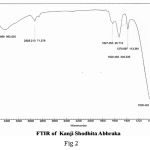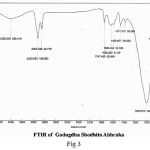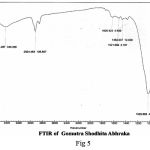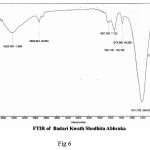Manuscript accepted on :April 29, 2009
Published online on: 12-11-2015
Plagiarism Check: Yes
Pankaj Rai¹, Neeraj Kumar² and R.S. Singh³
1Reader and Head, Department of Rasa Shastra, Faculty of Ayurveda, Institute of Medical Sciences, Banaras Hindu University India.
2Department of Chemical Engineering Institute of Technology, Banaras Hindu University India.
Corresponding Author E-Email: vaidyaraipankaj@rediffmail.com
Abstract
Krishna Vajra Abhraka (Biotite) is an important and potent mineral used as medicine for different therapeutic purposes in the Ayurveda since long back. Abhraka is not used directly in the native form as founds in the ore. It is subjected to different pharmaceutical processing like Shodhana and Marana (incineration) described in Ayurvedic texts that converts into therapeutically important form. These processes lead to physico-chemical changes in the Abhraka which makes therapeutically suitable form. In this paper an attempt has been made to find out the chemical changes takes place in the Abhraka after process of Shodhana from different Media by Fourier transmission Infrared Spectroscopy Study (FTIR).
Keywords
Krishna Vajra Abhraka; Shodhana; Fourier transmission; Infrared Spectroscopy Study; Media
Download this article as:| Copy the following to cite this article: Rai P, Kumar N, Singh R. S. Role of Media in the Pharmaceutical Processing of Krishna Vajra Abhraka - A Fourier Transmission Infrared Spectroscopy Study (FTIR). Biomed. Pharmacol. J.2009;2(1) |
| Copy the following to cite this URL: Rai P, Kumar N, Singh R. S. Role of Media in the Pharmaceutical Processing of Krishna Vajra Abhraka - A Fourier Transmission Infrared Spectroscopy Study (FTIR). Biomed. Pharmacol. J.2009;2(1). Available from: http://biomedpharmajournal.org/?p=613 |
Introduction
Metallic and mineral preparations are in frequent use for therapeutic purposes in Indian System of Medicine especially Ayurveda since many centuries. During the medieval period (8th – 10th century) many pharmaceutical processing’s like Shodhana, Jarana, Marana (incineration), Satvapatana (extraction) etc. developed in Ayurveda for metallic and mineral preparations. Above developments resulted in more frequent use of Metallic and Mineral preparations in therapeutics and drugs prepared using above processes are known as Rasaushadhies. These Rasaushadhies have innate qualities like quick action, lesser dose; tastelessness, prolonged self-life & better palatability 1.Due to these qualities metallic and mineral preparation have given a unique, comprehensive health care approach to Indian system of medicine for serving as global medical system. In Ayurvedic pharmaceutics the process of Shodhana has its importance because the dravyas (materials) used for medicinal purposes are of metal, mineral, vegetable and animal origin. Shodhana is a process of purification and detoxification by which physical and chemical blemishes, toxic materials are eliminated & substances are made suitable for further processing. So the process of Shodhana 2 is an essential process to remove the external impurities as well as to make the drug ready for other pharmaceutical processes.
According to Ayurvedic texts, Shodhana should be done before using the Abhraka because Ashodhit (unpurified) Abhraka3 produces harmful effects like Kustha (leprosy), Pandu (anemia), Shotha (swelling), Hritshula (chest pain), etc. Most acceptable Shodhana process of Abhraka described in Ayurvedic texts is Nirvapa 4, 5 process (Heating to red hot stage and immediately quenched in media). Many liquid Media are described in Ayurvedic text for this purpose6 and were also used by different workers 7-9 for the Shodhana process of Abhraka. This process converts Abhraka into suitable form for further processing. Recent advances in analytical techniques such as spectroscopy, electron microscopy, crystallography etc. have provided unprecedented view of structure of drug that can be used to analyze the effect of these processes on raw material.
Materials and Methods
Materials
Abhraka used for the present study was procured from Ayurvedic Pharmacy, Institute of Medical Sciences, Banaras Hindu University. Then it was subjected to Shodhana process according to traditional Ayurvedic procedures. Abhraka was taken in an iron pan and required amount of liquid media(Kanji, Godugdha, decoction of Triphala, Gomutra and decoction of Badari)was taken in separate steel vessel. Iron pan was kept on charcoal burner and peak temperature of charcoal burner was maintained with the help of electric blower. Abhraka flakes were turned up & down with metal tongs to provide equal exposure of heat to both the surfaces. It was done in regular intervals. When the Abhraka flakes reached at the stage of red hot, it was quickly quenched into the media with the help of metal tongs. The medium was separated by filtering it through iron sieve and soft pieces of Abhraka were collected in an iron pan. Process is repeated for seven times in each medium like Kanji (gruel), Godugdha (cow’s milk), decoction of Triphala {pieces of dry fruits of Haritaki (Emblica officinalis), Vibhitaki (Terminalia bellirica) & Amalaki (Terminalia chebula) }, Gomutra (cow’s urine) and decoction of Badari (Zizyphus Jujuba) separately. Different Media are taken out for comparative analysis of effect of media on the Shodhana process. Abhraka obtained after seven times is shodhit one and collected separately in sterile glass for further studies. The pH of these Media are tabulated in table 1.
Table 1: The pH of Media used for Shodhana process are as follows.
| Media | pH |
| Triphala kwath | 3 – 4 |
| Godugdha | 6..6 – 6.8 |
| Gomutra | 8 – 8.5 |
| Badari kwath | 8 – 9 |
| Kanji | 3 – 3.4 |
Method
Samples of raw Abhraka and shodhit Abhraka were taken and grounded with Potassium Bromide (KBr) to prepare sample for FTIR analysis. The samples were then subjected for Fourier transmission Infrared Spectroscopy analysis to find out the effect of different Media on the Shodhana process of Krishna Vajra Abhraka
Results and Discussion
The results of the FTIR studies are shown in Figure 1 to 6. The presence of various compounds in these samples can be analyzed on the basis of these figures and are presented in table 2 and 3.
 |
Figure 1:
|
 |
Figure 2:
|
 |
Figure 3:
|
 |
Figure 4:
|
 |
Figure 5:
|
 |
Figure 6:
|
Table 2: Common compound / functional group found in raw material and all shodhit samples.
| S.No. | Wavelength (Cm-1)
Vmax |
Common compound / Functional group |
| 2800-2950 | H-bonded acidic hydroxyl group | |
| 1630 | Water molecule | |
| 400-900 | Aluminum in both tetrahedral and octahedral coordination | |
| 350-550 | Magnesium compound | |
| 400-750 | Iron in both tetrahedral and octahedral coordination | |
| 900-1200, <500 | (SiO4)n | |
| 600-950 | (SiO6)n | |
| 750-1000 , 500 cm-1
|
(MoO6)n |
M= metal
Table 3: Different compound / functional group found in raw material and all shodhit samples.
|
Sample |
Wavelength (Cm-1)
( Vmax)
|
Common compound / Functional group |
| Raw Abhraka | 1376.741 | NO21- |
| 1376.741 | SO32- | |
| 1460.753 | M-OCO2 (CO) | |
| Kanji Shodhit Abhraka | 1370.997 | NO21- |
| 1370.997 | SO32- | |
| 1520.450 | M-OCO2 (CO) | |
| Godugdha Shodhit Abhraka | 1377.273 | NO21- |
| 1377.273 | SO32- | |
| 1583.434, 1460.657 | M-OCO2 (CO | |
| 1747.459 | M-CO | |
| Triphala Kwath Shodhit Abhraka | 1370.242 | NO21- |
| 1516.604 | M-OCO2 (CO) | |
| Gomutra Shodhit Abhraka | 1462 | NO21- |
| 1521 | (ONO) | |
| 1521.040 | M-OCO2 (CO) | |
| Badari Kwath Shodhit Abhraka
|
1374.599 | NO21- |
| 1374.599 | SO32- | |
| 1521.761 |
M-OCO2 (CO) |
The Fourier Transmission Infrared Spectroscopy spectra of the raw material and shodhit material done shows that H-bonded acidic hydroxyl group, water molecule, Aluminum and Iron in both tetrahedral and octahedral coordination, Magnesium compound, (SiO4)n, (SiO6) n, (MoO6) n are commonly present in each sample. The (MoO6) n peaks offered probable arise out of impurities in the metal present in the raw material and shodhit materials. The presence of water molecules is very strongly indicated in raw material Abhraka where as this absorption peak has diminished in peak of Triphala kwatha and cow’s milk shodhit (purified) Abhraka but it is strongly absorbed in other i.e. Kanji, Gomutra and Badari kwath shodhit Abhraka .
There are number of minor peaks of NO21- SO32- M-OCO2 (CO) and M-CO (M = unknown metal) are also found that arises in different regions indicate the presence of different compound / functional group in different samples. These peaks may be due to the small amounts of carbonates, nitrites and sulphate present in raw material and shodhit material. These small peaks indicates that the different liquid media used for the process of Shodhana leads to some addition and deletion of compounds / functional group in raw material that probably makes the material suitable for further pharmaceutical processing and for therapeutic use .
References
- Tripathi, I.D.: Gopalkrishna Bhata’s Rasaedra Sar Sangraha, Chaukambha Orientalia, Varanasi, 4, 2003.
- Shastri, K.N.: Sadanand Sharma’s Rasa Tarangani, Motilal Banarasi Das, Varanasi, 22, 2002.
- Sharma, Gulraj. : Madhava’s Ayurveda Prakash, Chaukambha Bharati Academy, Varanasi, 284, 1999.
- Mishra, S.N.: Yashodhar’s Rasa Prakash Sudhakar, Chaukambha Orientalia, Varanasi, 92, 2004.
- Kulkarani, D.A.: Rasa Vagbhata’s Rasa Ratna Sammucchaya, Meharchand Lacchman Das, New Delhi, 148, 1992.
- Mishra, S.N.: Somdeva’s Rasendra Chudamani, Chaukambha Orientalia, Varanasi, 139, 2004.
- Joshi. Damodar. etall, Pharmaceutical and Pharmacotherapeutics Studies on Abhraka Bhasma with special reference to Amlapitta, Department of Rasa Shastra, Institute of Medical Sciences, Banaras Hindu University, 98, 1973.
- Jha. C.B. etall, Standardization of Abhraka Satvapatana, Department of Rasa Shastra, Institute of Medical Sciences, Banaras Hindu University, 142, 1991.
- Kadam. Ajit. Etall, A Comparative Study of Abhraka Satva Bhasma and Loha Bhasma, Department of Rasa Shastra, Institute of Medical Sciences, Banaras Hindu University,128, 1997.







